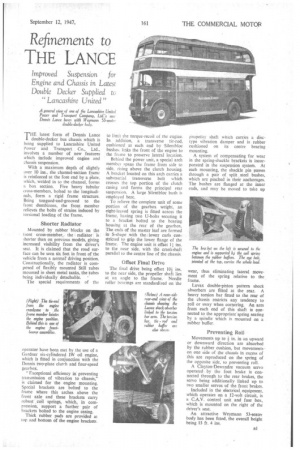Refinements to
Page 35

If you've noticed an error in this article please click here to report it so we can fix it.
THE LANCE
THE latest form of Dennis Lance double-decker bus chassis which is being supplied to Lancashire United Power and Transport Co., Ltd., involves a number of new features which include improved engine and chassis suspension.
With a maximum depth of slightly over 10 ins., the channel-section frame is reinforced at the fore end by a Plate, which, welded in to the channel, forms a box section. Five heavy tubular cross-members, bolted to the longitudinals, form a rigid frame structure. Being tongued-and-grooved to the. front dumbirons, the front member relieves the bolts of strains induced by iorsional loading of the frame.
Shorter Radiator Mounted by rubber blocks on the front cross-member;. the . •radiator is shorter than on previous models, giving increased visibility from the driver's seat. It is claimed that the road surface can be seen six feet in front of the vehicle from a normal. driving position. Constructionally, the radiator is composed of flexibly mounted Still tubes mounted in sheet metal tanks, the 'tubes
being individually detachable.
The special requirements of the operator have been met by the use of a Gardner six-cylindered IW oil engine, which is fitted in conjunction with the Dennis two-plate clutrh and four-speed gearbox.
"Exceptional efficiency in preventing transmission of vibration to chassis," is claimed for the engine mounting. Special brackets are bolted to the frame where this arches above the front axle and these brackets carry robust.. coil springs, which, in compression, support a further pair of brackets bolted to the engine casing.
Thick rubber pads are provided at top and bottom of the engine brackets. to limit the torque-recoil of the engine. In addition, a transverse tie-rod, cushioned at each end by Silentbloc bushes: links the front of the engine to the frame to preserve lateral location.
Behind the power unit, a.special arch member spans the frame from side to side, rising above the clutch housing. A bracket located on this arch carries a substantial transverse bolt which crosses the top portion of the clutch casing and forms the principal rear suspension. A large Silentbloc bush is employed here.
To relieve the complete unit of some portion of the gearbox weight, an eight-leaved spring is fitted across the frame, having two U-bolts securing it to a bracket bolted to the bearing housing at the rear of the gearbox. The ends of the master leaf are formed in' S-shape with the lower curls constricted to grip the lower flange of the frame. The engine unit is offset 1,1 ins. to the near side, with the crankshaft parallel to the centre line Of the chassis.
Offset Final Drive
The final drive being offset 10i ins. to the near side, the propeller shaft lies at an angle to the frame, • Needle roller bearings are standardized on the propelicr shaft which carries a disctype vibration damper and is rubber cushioned on its centre bearing mounting.
A system of compensating for wear in the spring-shackle brackets is incorporated in the suspension system. At each mounting, the shackle pin passes through a pair of split .steel bushes, which are pinched in their anchorages. The bushes are flanged at the inner ends, and may be moved to take up wear, thus eliminating lateral movement of the spring relative to the frame.
Luvax double-piston pattern shock absorbers are fitted at the rear. A heavy torsion bar fitted to the rear of the chassis restricts any tendency to roll or sway when cornering. An arm from each end of this .shaft is connected to the appropriate spring seating by a spindle which is mounted on a rubber buffer.
Preventing Roll
Movements up to in. in an upward or downward direction are absorbed by the rubber cushion, but movements' on one side of the chassis in excess of this are reproduced on the spring of the opposite side, so preventing roll.
A Clayton-Dewandre vacuum servO operated , by the foot brake is connected through to the rear brakes, the servo being additionally linked up to two smaller servos -of the front brakes.
Included in the electrical equipment, which operates on a 12-volt circuit, is a C.A.V. control unit and fuse box, which is mounted on the right of the driver's seat.
An attractive Weymann 53-seater body has been fitted, the overall height being 13 ft. 4 ins.




















































































